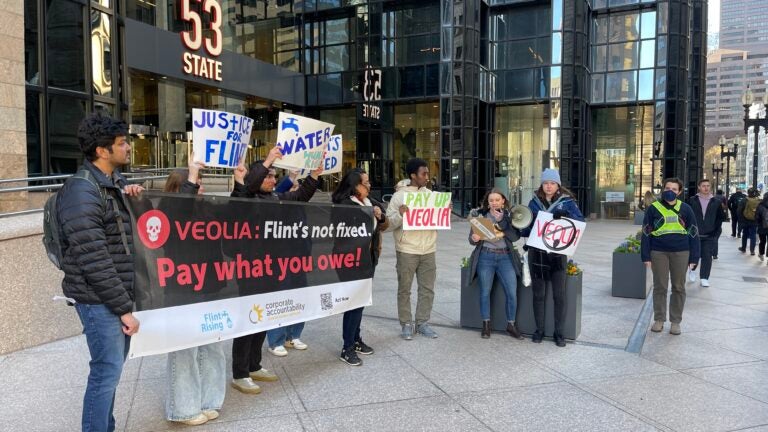A decade after the Flint water crisis, these Boston residents are still campaigning for justice
A decade after the Flint water crisis, these Boston residents are still campaigning for justice Boston.com


About a dozen protesters demand accountability from Violia in Flint water crisis

Introduction
On April 25, 2014, the former mayor of Flint, Mich., officially switched the city’s water supply from Lake Huron to the Flint River, marking the start of a years-long health crisis for hundreds of thousands of city residents that drew national attention.
A decade later, about a dozen people gathered in Boston to protest corporations’ role in the crisis and demand justice for the people affected.
“A lot of folks think the water crisis has been resolved, the unfortunate reality is that a decade has gone by and Flint still doesn’t have reliable access to safe drinking water,” said Neil Gupta, the water campaign director at Corporate Accountability. “Flint residents haven’t seen a penny of compensation for what they’ve gone through.”
Protest against Veolia’s role in the crisis
Thursday’s demonstration, organized by the non-profit Corporate Accountability, specifically targeted Veolia, the world’s largest private water corporation. About a dozen protesters held signs reading “Justice for Flint” and “Flint Not Fixed” in front of Veolia’s North American headquarters in Boston.
What is Veolia’s role in the crisis?
Veolia was one of the companies contracted in early 2015 to assess Flint’s drinking water system. A class action suit filed against the firm by Flint residents says the company failed to identify corroding pipes and acted too slowly to address water contamination, according to reporting by the Detroit Free Press.
A $25 million settlement was reached in the suit in February, but protesters at Thursday’s march demanded more reparations from the company. Reporting by The Guardian in 2019 revealed that Veolia and city officials knew that lead from the city’s pipes could be leaching into drinking water, but Veolia did not recommend that the public stop drinking the city’s water.
Consequences from the crisis are ongoing
After the City switched its water supply to the Flint River in 2014 for cost-cutting measures, Flint residents reported foul-tasting, discolored water. Tests showed elevated levels of carcinogens, including lead, but city officials continued to tell residents it was safe to drink.
Over the course of several years, thousands of people were sickened and 12 died from drinking contaminated water. Residents also reported increased behavioral health issues, anxiety and depression, and worsened physical health, according to the CDC.
Protesters demanded that Veolia owns up to its role in the crisis, stops fighting legal battles about money owed to residents, replaces all lead pipes in Flint, and meets with community members to hear their concerns.
Veolia stands by its work in Flint
Veolia Environment shareholders met in Paris on the same day as the protest. The company defended its work in Flint, stating that it made good recommendations that were ignored by government officials responsible for implementing them.
Environmental justice and the Flint water crisis
Speakers at the demonstration highlighted the issue of environmental racism and injustice in the management of the Flint water crisis. Flint, a majority Black community with a relatively high poverty rate, has faced long-standing marginalization.
“Conversations of environmental justice are especially important in a city like Boston, which has a long history of redlining and consistent marginalization of minority populations,” said Chris Mesfin, a student at Harvard and environmental organizer. “The action that should be taken for Flint applies to the environmental justice community in Boston, the U.S., and across the world.”
SDGs, Targets, and Indicators
-
SDG 6: Clean Water and Sanitation
- Target 6.1: By 2030, achieve universal and equitable access to safe and affordable drinking water for all.
- Target 6.3: By 2030, improve water quality by reducing pollution, eliminating dumping and minimizing release of hazardous chemicals and materials, halving the proportion of untreated wastewater, and substantially increasing recycling and safe reuse globally.
- Indicator 6.1.1: Proportion of population using safely managed drinking water services.
- Indicator 6.3.2: Proportion of bodies of water with good ambient water quality.
-
SDG 10: Reduced Inequalities
- Target 10.2: By 2030, empower and promote the social, economic, and political inclusion of all, irrespective of age, sex, disability, race, ethnicity, origin, religion or economic or other status.
- Indicator 10.2.1: Proportion of people living below 50 percent of median income, by age, sex, and persons with disabilities.
Analysis
1. Which SDGs are addressed or connected to the issues highlighted in the article?
The issues highlighted in the article are connected to SDG 6: Clean Water and Sanitation and SDG 10: Reduced Inequalities.
2. What specific targets under those SDGs can be identified based on the article’s content?
Based on the article’s content, the specific targets that can be identified are:
– Target 6.1: Achieve universal and equitable access to safe and affordable drinking water for all.
– Target 6.3: Improve water quality by reducing pollution, eliminating dumping, and minimizing the release of hazardous chemicals and materials, halving the proportion of untreated wastewater, and substantially increasing recycling and safe reuse globally.
– Target 10.2: Empower and promote the social, economic, and political inclusion of all, irrespective of age, sex, disability, race, ethnicity, origin, religion, or economic or other status.
3. Are there any indicators mentioned or implied in the article that can be used to measure progress towards the identified targets?
Yes, there are indicators mentioned or implied in the article that can be used to measure progress towards the identified targets:
– Indicator 6.1.1: Proportion of population using safely managed drinking water services.
– Indicator 6.3.2: Proportion of bodies of water with good ambient water quality.
– Indicator 10.2.1: Proportion of people living below 50 percent of median income, by age, sex, and persons with disabilities.
Table: SDGs, Targets, and Indicators
| SDGs | Targets | Indicators |
|---|---|---|
| SDG 6: Clean Water and Sanitation |
|
|
| SDG 10: Reduced Inequalities |
|
|
Copyright: Dive into this article, curated with care by SDG Investors Inc. Our advanced AI technology searches through vast amounts of data to spotlight how we are all moving forward with the Sustainable Development Goals. While we own the rights to this content, we invite you to share it to help spread knowledge and spark action on the SDGs.
Fuente: boston.com

Join us, as fellow seekers of change, on a transformative journey at https://sdgtalks.ai/welcome, where you can become a member and actively contribute to shaping a brighter future.







